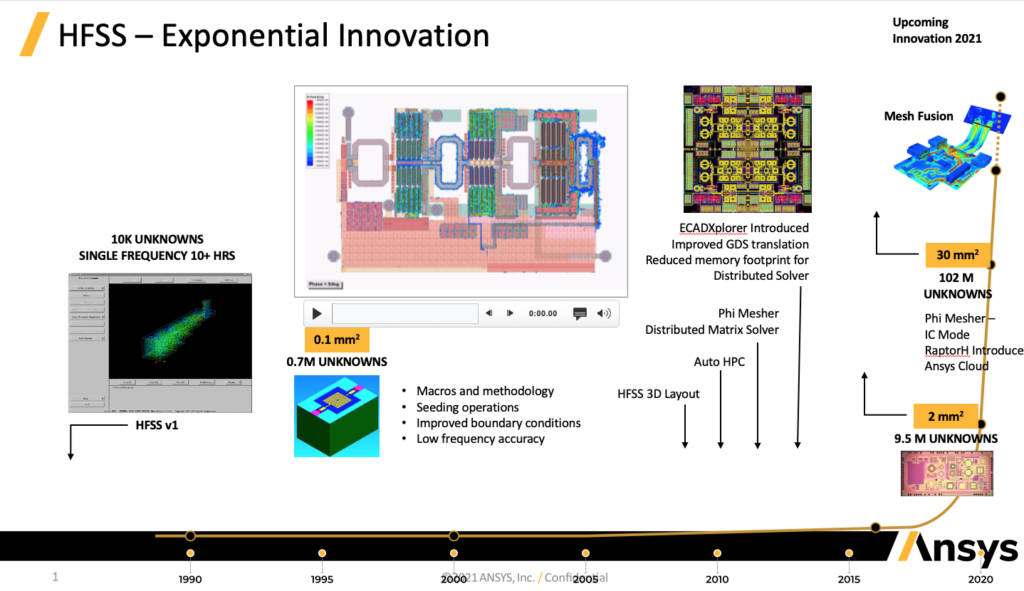Moore’s Law is the most iconic statement of exponential technology advancement, doubling transistor count and hence functional performance every 24 months. Many pundits [1-3] have observed that while technology advancement is exponential, human expectations are linear. We often fail to anticipate when a technology may arrive in short order. Electromagnetic simulation has delivered exponential improvements in capacity and speed, but even my Ansys colleagues and I are often pleasantly surprised in the increase in size and scope of problems solved with each new software release.
Ansys HFSS is used by engineers to solve challenging design problems in microwave, wireless, high-speed electronics, and integrated circuits. First introduced to microwave engineers 30 years ago, it provided the ability to solve any 3D component with virtually any material property. Engineers quickly adopted design on the computer rather than building microwave hardware for testing, changing how microwave products were delivered.
In those early days, we were able to solve problems of roughly 10,000 unknowns. Ansys recently solved a radio frequency integrated circuit (RFIC) layout with over 100M unknowns! As measured by performance, innovation has been exponential: 10,000 unknowns in 1990 to over 100M unknowns today (see figure).
Electromagnetic simulation advances outpace Moore’s Law
You may be thinking that the solver performance advancements are due entirely to Moore’s Law, but there is more to it than that. The combination of Moore’s Law multiplied by advances in solver technologies produced that tremendous performance increase. Advanced meshing algorithms; direct, iterative, and distributed matrix solvers; parallel meshing and solving techniques; and distributed fast frequency sweeps are just a few of the pioneering efforts that have contributed to speed and capacity increases.
In integrated circuit (IC) design we are challenging engineers’ perception of what is possible. Designing high-performance electronics — from cell phones to computers to complex radar systems — depends on the ability to accurately simulate ICs, which have steadily increased in density and speed to handle the growing needs of computation, data handling and communication.

Since its introduction in 1990, Ansys HFSS performance innovation has been exponential: 10,000 unknowns in 1990 to over 100M unknowns today.
The late 1990s ushered in the RF complementary metal oxide semiconductor (CMOS) revolution, making it possible to integrate radio circuits into the same IC process that is used for digital signal processing. Engineers began to apply HFSS to simulate RF CMOS on-chip components and component-to-component coupling — a totally new application. Addressing the new challenge required specialized technologies including 3D layout meshing and IC mode solvers that today can solve IC design problems of 100M unknowns.
A recent blog co-published by Microsoft and Ansys described how Ansys HFSS was able to solve a 5.5 x 5.5mm section of an RFIC at 5GHz in under 32 hours by bringing together IC-centric meshing in HFSS 3D Layout and the distributed compute power of Ansys Cloud on Azure. This was unheard of just six months ago. Until recently, it was impossible to simulate a full RFIC with a high level of accuracy because of the design’s complexity and limitations in solving and meshing technology. Engineers had to compromise their design flow in ways that slowed time to market and increased development cost and risk.
New possibilities for electromagnetic simulation
Full IC HFSS simulation can help companies avoid mistakes and missed problems, which could lead to millions of dollars in unplanned non-recurring engineering (NRE) cost as well as delaying time to market by weeks or even months. This innovation is creating immediate value for designers.
“We never expected to be able to sign off a large design like this in HFSS,” said the package design lead at a Silicon Valley-based custom ASIC house specializing in high-speed networking and communications. “We tried solving this larger structure in another recently released FEM-based solver but were never able to complete the analysis.”
This customer was so used to working within the limitations of old processes that they did not realize what is now possible.
We continue to deliver new innovations. Ansys HFSS Mesh Fusion in Ansys 2021 R1 makes it possible for engineers to quickly tackle their most difficult engineering challenges at a scale that was impossible to imagine just a few months ago. This breakthrough technology enables assembly of full electronic systems, from ICs to printed circuit boards (PCBs) to fully integrated electronic systems with distributed simulation on high-performance computers and the Cloud. Mesh Fusion solves the most challenging large and complex designs, such as system-level electromagnetic interference/compatibility (EMI/EMC), antenna on platform, IC on package or any other complex EM system.
What will you do with advancements in design engineering simulation based on real physics? Shrewd design organizations leverage exponential simulation innovation to deliver exponentially innovative products. As the physical and digital worlds merge, we are witnessing disruption in product development that results in unprecedented new products. Those exponential technology products can be delivered faster with greater reliability by applying exponential technology simulation.
References
[1] Peter Diamandis. https://su.org/concepts/


